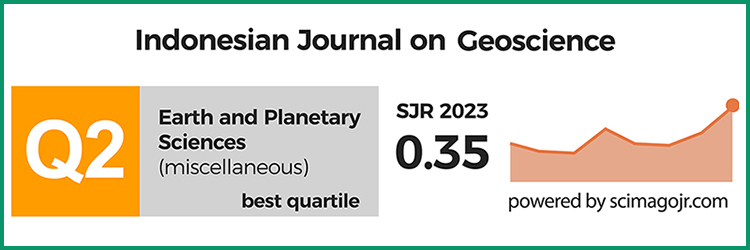Tinjauan Kemungkinan Sebaran Unsur Tanah Jarang (REE) di Lingkungan Panas Bumi
DOI:
https://doi.org/10.17014/ijog.4.1.1-8Keywords:
rare earth elements, geothermal, hydrothermal systemAbstract
https://dx.doi.org/10.17014/ijog.vol4no1.20091
Geothermal areas occur mainly in an environment of volcanic/magmatic arc where magma chambers play a role as heat sources. The environment is situated within the convergent plate boundaries. A variety of igneous rocks is associated with this environment ranging from basalt (gabbro) to rhyolite (granite) but andesite is normally the most abundant igneous rock. The most obvious geothermal indications are exhibited by some surface manifestations comprising hot water seepage, fumaroles, hot spring, geyser, and hydrotermal alteration zones which are being evidences of an active hydrothermal system beneath the surface as a part of volcanism.
Despite being a causal factor for alteration of country rocks, most hydrothermal fluids enable to change distribution pattern and content of rare earth elements (REE for instance Ce, Eu, La, Lu, Sm, Nd, and Y) particularly during a reaction process. This may have a connection with development of element mobility rates, whilst the characteristics of REE pattern within hydrothermal fluid would have a high variable due to dependency of their original magma source.
Considering the important role of hydrothermal fluid in REE mobility development, it is inspired to review the possible relationship of active hydrothermal system and potency of REE distribution pattern in areas of geothermal manifestation.
References
Adams, J.W., 1969. Distribution of lanthanides in minerals, U.S. Geological Survey, Professional Paper, 650-C, h.38-44.
Bergen, M.J. van, Bernard., A., Sumarti, S., Sriwana, T., dan Sitorus, K., 2000. Crater lakes of Java: Dieng, Kelud and Ijen. Excursion Guidebook, IAVCEI General Assembly, Bali, 9 h.
Ellis, A.J., 1969. Present day hydrothermal systems and mineral deposition: Commonwealth Mining and Metalurgy Congress, 9th. dalam: Simmon, et al., 1994: Origin of Calcite in boiling geothermal system. American Journal of Science, 294, h.361-400.
Fleischer, M., 1978a. Relative proportions of the lanthanides in the minerals of the bastnasite group. Canadian Mineralogy, 63, h.869-873.
Fleischer, M. dan Altschuler, Z.S., 1969. The relationship of the rare earth composition of minerals to geological environment. Geochimica et Cosmochimica Acta, 33, h.725-732.
Graf, J.L., Jr., 1977. Rare earth elements as hydrothermal tracers during the formation of massive sulphide deposits in volcanic rocks. Economic Geology, 72, h.527-548.
Heald., P., Foley, N.K., dan Hayba, D.O., 1987. Comparative anatomy of volcanic-hosted epithermal deposits: acid- sulfat and adularia-sericite deposits. Economic Geology, 82, h.1-26.
Henderson, P., 1982. Rare Earth Element Geochemistry, Developments in Geochemistry 2, Elsevier, Amsterdam- Oxford-New York-Tokyo, 510h.
Henley, R.W. and Ellis, A.J., 1983. Geothermal system ancient and modern: a geothermal review. Earth Science Revision, 19, h.1-50.
https://www.vsi.esdm.go.id/volcanoes/dieng/geology.html, 2008. Geology of Dieng Volcanic Complex.
Jaffe, H.W., Meyrowitz, R., dan Evans, H.T., Jr., 1953. Sahamalite, a new rare earth carbonate mineral. American Mineral, 38, h.741-754.
Kerrich, R. dan Fryer, B.J., 1979. Archaean precious-metal hydrothermal systems, Dome Mine, Abitibi Greenstone Belt, II, REE and oxygen isotope relations. Canadian Journal Earth Science, 16, h.440-458.
Knapp, R.B. dan Knight, J.E., 1977. Differential thermal expansion of pore fluids: fracture propagation and microearthquake production in hot pluton environments, Journal of Geological Research, 82, h.2515-2522.
Mineyev, D.A., 1963. Geochemical differentiation of the rare earths. Geochemistry (U.S.S.R), 12, h.1129-1149.
Moller, P., Morteani, G., Hoefs, J., dan Parekh, P.P., 1979. The origin of the ore-bearing solution in : Pb-Zn veins of the western Harz, Germany, as deduced from rare-earth element and isotope distributions in calcites. Chemical Geology, 26, h.197-215.
Morgan, J.W. and Wandless, G.A., 1980. Rare earth element distribution in some hydrothermal minerals: evidence for crystallographic control. Geochimica et Cosmochimica Acta, 44, h.973-980.
Muffler, L.J.P., White, D.E., dan Truesdell, A.H., 1971. Hydrothermal explosion craters in Yellowstone National Park. Geological Society of American Bulletin, 82, h. 723-740.
Nairn, I.A. dan Solia, W., 1980. Late Quaternary hydrothermal explosion breccias at Kawerau geothermal field, New Zealand. Bulletin of Volcanology, 43, h.1-13.
Norton, D.R., 1984. Theory of hydrothermal system. Annual Revision of Earth Planet Science, 12, h.155-177.
Wedepohl, K. H. (ed.), 1970. Handbook of Geochemistry, II/5, Springer-Verlog, Berlin, h.39, 57-71-D-1.
Sillen, L.G., dan Martell, A.E., 1964. Stability constants of metal-ion complexes. Chemical Society of London, Special Publication, 17, 754 h.
Tim Penelitian Konservasi Dieng, 2008. Laporan Pendahuluan Penelitian Mineral Ikutan Pada Lapangan Panasbumi Di Daerah Dieng, Kabupaten Banjarnegara, Jawa Tengah; Kelompok Program Penelitian Konservasi, Pusat Sumber Daya Geologi.
Van Wambeke, L., 1977. The Karonge rare earth deposits, Republic of Burundi new mineralogical-geochemical data and origin of the mineralization. Mineral Deposita, 12, h.373-380.



















